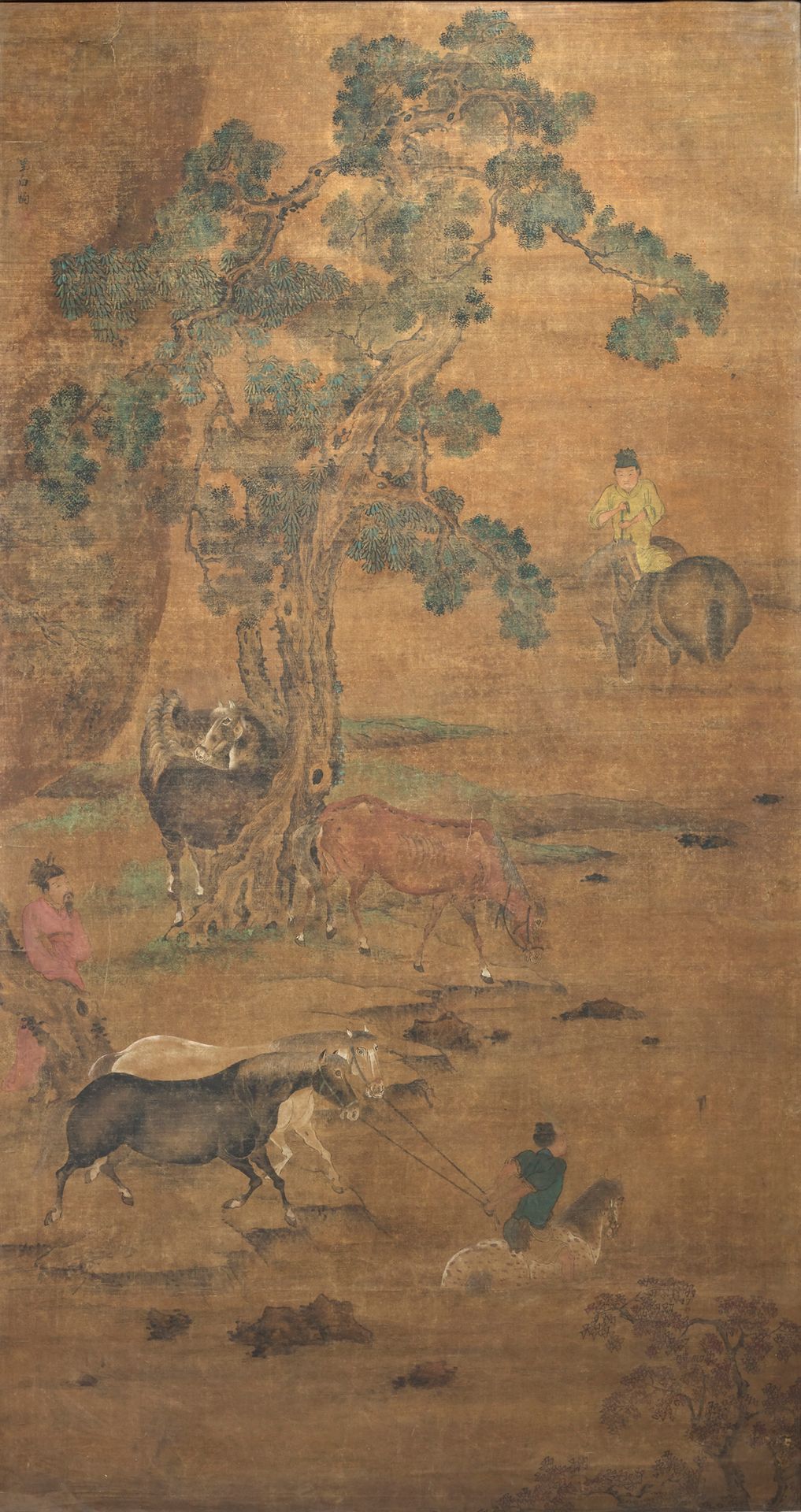Description
CHINE FIN DE LA DYNASTIE MING ET DÉBUT DE LA DYNASTIE QING, XVIIe SIÈCLE, DANS LE STYLE DES YUAN
Important painting in ink and colors on silk, titled in the upper left corner "Hei Bai Ju" (The Eight Horses), representing horses and grooms at rest in a landscape crossed by a river, the oldest horse going to quench his thirst under a longevity pine tree with a gnarled trunk. The two grooms are taking advantage of this stop to lead the seven other healthy horses to the bath, under the watchful eye of their master, leaning against a tree trunk. Sight size : 196,4 x 102 cm (Framed under glass, old restorations) PROVENANCE Private Parisian collection of Mr. L. constituted over three generations since the end of the 19th century. N.B. This delicate work is representative of the importance of horses in classical Chinese art. The clothes of the riders and the way of painting the horses find their inspiration here in the representations of the end of the Song and the Yuan. The horses here are vigorous, with finely shaded coats. One of the horses is drinking from the river. Dripping with water, it can be seen as a metaphor for the state of fatigue resulting from the war in the last years of Song, echoing the end of the Ming period. The legs of the horses are thin and contrast with the muscular bodies, symbolizing agility and strength. This painting is a legacy of centuries-old artistic traditions. It mixes poetry, symbolism and virtuosity. Its finesse and elaboration make it an important witness of the late Ming and early Qing periods. Since ancient times, horses have played a very important role in classical Chinese art. It is not only an account of Tang Taizong's brilliant achievements, such as "Six Horses of Zhaoling". But also a symbol of the self-proclaimed talents of scholars. In such an atmosphere, the subject of pommel horse developed rapidly and a large number of outstanding pommel horse writers appeared. This work represents the Eight Horses, with delicate brushwork. From the clothing of the characters and the method of painting the pommel horse, we can see the "style" of the late Song and Yuan dynasties. Among the eight horses, most of the horses are vigorous and rich in decorative style. The horse drinking water is thin and dripping, or a metaphor for the tired state of war in the later years of the Song Dynasty. The other seven horses, like the black and white horses in the foreground, have extremely thin legs, which form a stark contrast to the plump body, and the groom holds the reins in his hand to cross the river. In addition, the two horses under the tree in the middle of the scene are looking at each other, as if they are communicating. The horses have a simple shape, and the marks of the horses are similar to the painting of "Five Kings Drunk Revenant" painted by Ren Renfa in the Yuan Dynasty. However, the horses in the water in the distance are more calm and peaceful like the Song horses, and their expressions are also more realistic. Except for the trees and rocks and the rubbing at the foot of the slope, the whole work adopts the Tang Dynasty "empty hook without tracing" painting method. First, the outlines of the mountain and rock are outlined by lines, and then paint is applied to fill in the color. In this way, the color and ink of the image are integrated, and the decorative effect is rich.
102
CHINE FIN DE LA DYNASTIE MING ET DÉBUT DE LA DYNASTIE QING, XVIIe SIÈCLE, DANS LE STYLE DES YUAN
